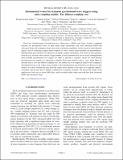Instrumental vetoes for transient gravitational-wave triggers using noise-coupling models: The bilinear-coupling veto
Author(s)
Ajith, Parameswaran; Isogai, Tomoki; Christensen, Nelson; Adhikari, Rana X.; Pearlman, Aaron B.; Wein, Alex; Weinstein, Alan J.; Yuan, Ben; ... Show more Show less
DownloadPhysRevD.89.122001.pdf (1.202Mb)
PUBLISHER_POLICY
Publisher Policy
Article is made available in accordance with the publisher's policy and may be subject to US copyright law. Please refer to the publisher's site for terms of use.
Terms of use
Metadata
Show full item recordAbstract
The Laser Interferometer Gravitational-wave Observatory (LIGO) and Virgo recently completed searches for gravitational waves at their initial target sensitivities, and soon Advanced LIGO and Advanced Virgo will commence observations with even better capabilities. In the search for short-duration signals, such as coalescing compact binary inspirals or “burst” events, noise transients can be problematic. Interferometric gravitational-wave detectors are highly complex instruments, and, based on the experience from the past, the data often contain a large number of noise transients that are not easily distinguishable from possible gravitational-wave signals. In order to perform a sensitive search for short-duration gravitational-wave signals it is important to identify these noise artifacts, and to “veto” them. Here we describe such a veto, the bilinear-coupling veto, that makes use of an empirical model of the coupling of instrumental noise to the output strain channel of the interferometric gravitational-wave detector. In this method, we check whether the data from the output strain channel at the time of an apparent signal is consistent with the data from a bilinear combination of auxiliary channels. We discuss the results of the application of this veto to recent LIGO data, and its possible utility when used with data from Advanced LIGO and Advanced Virgo.
Date issued
2014-06Department
Massachusetts Institute of Technology. Department of PhysicsJournal
Physical Review D
Publisher
American Physical Society
Citation
Ajith, Parameswaran, et al. "Instrumental vetoes for transient gravitational-wave triggers using noise-coupling models: The bilinear-coupling veto." Phys. Rev. D 89 (June 2014), 122001. © 2014 American Physical Society
Version: Final published version
ISSN
1550-7998
1550-2368